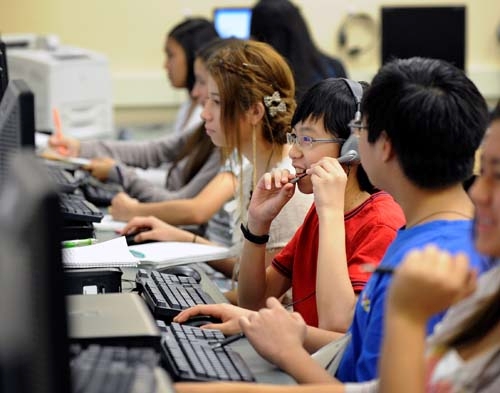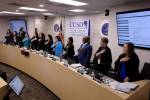Online class attracts savvy sixth-graders
Sixth-grader Kelsey Antolick may not know it as she arrives at school an hour early, but she's proof that the Clark County School District's goal of enrolling one in three students in online courses by 2015 is materializing.
At 8 a.m. on Thursday, Kelsey and 29 other eager students at Henderson's Webb Middle School volunteer as guinea pigs. Her class joins 30 students at Fremont Middle School, near Sahara Avenue and Maryland Parkway, in testing online courses the district plans to offer in grades six to eight next year.
It's undecided which middle schools will be offering online courses next year and how many students will be accepted, said Jhone Ebert, the district's chief technologies officer. The Clark County School Board on Thursday approved spending $288,000 for 28 online courses in middle school and high school.
One thing is certain - there's demand.
When Webb opened 30 spots for a spring online World Survey course that exposes students to six languages and cultures in a semester, 184 students applied. That came as a total surprise, Ebert and Webb Principal Paula Naegle said.
"There's a real appetite for this," said Naegle, noting that all students who signed up for the World Survey class are passing and none have dropped out. "The kids are so comfortable with technology."
Not only that, the district's Virtual High School, which opened in 2004 to offer an online alternative to brick-and-mortar high schools, experienced a 33 percent jump in students enrolled exclusively in online courses this spring after a flat fall semester enrollment of 150 students.
"That was a surprise," Ebert said.
Also, the number of Clark County high school students taking just one or two online courses increased by 37 percent this year to 12,000.
Even though classes are online, students still have teachers to call, email, text and meet with for guidance if they need it. Teachers create their own tests and make sure students stay on track.
That has worked for high school students, but are middle school students independent enough for the virtual classroom?
"Middle school kids, I don't think they're ready for it," said Spanish teacher Ana Thomann, who is co-teaching Webb's pilot online course this spring. "The majority of them still need someone behind them."
That threshold is what the district is testing this semester with Kelsey and her peers. The World Survey course isn't a true online course but a "blended" model. Students have two hours of class time a week in Webb's computer lab with Thomann and computer teacher Pam Dusseau. They must also do two hours of work at home.
While Thomann cautions against exclusively online courses for middle schoolers, she supports the blended model.
Online courses also allow students to progress at their own pace. Kelsey, who is taking accelerated courses, likes that because she's often waiting in math and science classes for her peers. But she also realizes it's helpful for students who struggle and are embarrassed to ask the teacher to repeat a topic.
"In class, all students are forced to go back even if they already understand the concept," said Spanish teacher Thomann, noting that students in the pilot program can listen to a word over and over until they get it.
As for learning the technology, she said it took two weeks to teach students how to submit assignments, record audio and other required tasks. That was longer than expected but does prepare them for Virtual High School, she said.
But what is the ultimate benefit of online courses? Are middle school students ready for virtual classrooms? Should the district solely offer blended models of mixed class and online time?
Simply put, school officials don't know yet. To answer those questions, the district has assembled a task force of teachers, principals, community members and students.
The obvious advantages are cost savings and the ability to offer classes that schools can't provide, said task force member and White Middle School Principal Jesse Welsh.
Funding dried up for Spanish classes at White, so Welsh told students they could take it through Virtual High School. Also, a handful of advanced students at the Henderson school are ready for geometry, but there aren't enough of them to fill a classroom, he said.
But there's so much more potential in pursuing instruction by way of computers and the Internet, he said.
"I've always said if they can find it on Google search, why are we teaching it?" said Welsh, who believes more emphasis should be placed on critical thinking and less on rote memorization of facts.
"It becomes less about the information and more about what you're going to do with it, critical thinking," Welsh explained. "What are the skills they really need to know?"
But he and task force member Sam Kim do have concerns. Kim, senior director of Enterprise IT for Caesars Entertainment, warned against stunted socializing and teamwork skills that could result from a lack of opportunities for students to interact.
Kim said, "At the end of the day, if we do it right, there will tremendous upsides."
Contact reporter Trevon Milliard at
tmilliard@reviewjournal.com or 702-383-0279.




























